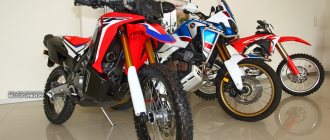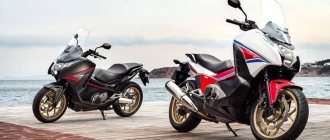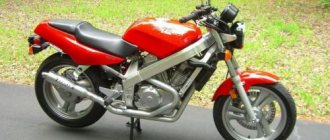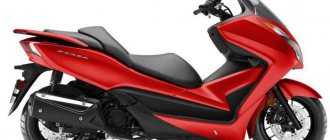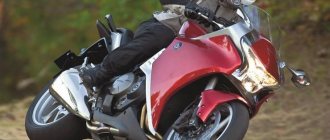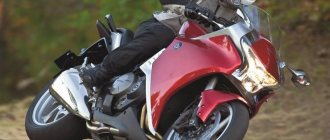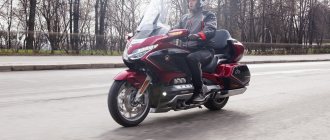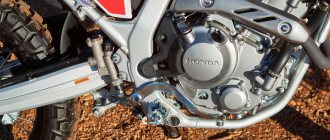14K 6 min.
Is it really possible to buy a new crossover with an automatic transmission, and from a respected Japanese brand, for less than half a million rubles? Don't even argue - it's absolutely real. True, it will not be a car, but a motorcycle.
Previous photo
Many motorcyclists, contrary to traffic rules, use high beam headlights during the day to be more visible.
Photo: Kommersant / Dmitry Lebedev / buy photo
Although the windshield is tiny, the effect of its presence is clearly noticeable, especially at high speeds
Photo: Kommersant / Dmitry Lebedev / buy photo
Carrying luggage options on a motorcycle are limited, but special accessories can go a long way toward solving this problem.
Photo: Kommersant / Dmitry Lebedev / buy photo
Next photo
1 / 3
Many motorcyclists, contrary to traffic rules, use high beam headlights during the day to be more visible.
Photo: Kommersant / Dmitry Lebedev / buy photo
Although the windshield is tiny, the effect of its presence is clearly noticeable, especially at high speeds
Photo: Kommersant / Dmitry Lebedev / buy photo
Carrying luggage options on a motorcycle are limited, but special accessories can go a long way toward solving this problem.
Photo: Kommersant / Dmitry Lebedev / buy photo
VASILY OSTROVSKY
About the diversity of species
In the world of motorcycles, the same processes are now seething as in the automobile market - the active mixing of different classes and the development of newly formed niches. The traditional classification is bursting at the seams, unable to cope with the influx of new models that do not fit into the existing canons. For example, crossovers are a relatively new genre for the two-wheeled industry. As you might guess, a crossover should be understood as a purely highway vehicle, which is endowed with some features characteristic of off-road vehicles. The Honda NC750XD readily fits into this format: it is stylized as a serious touring enduro (the beak under the headlight alone is worth it), moreover, compared to ordinary asphalt motorcycles, it has a slightly increased ground clearance and slightly longer-travel suspensions. In general, the appropriate surroundings are present, and no one demands more from an SUV.
Apparently, the development of the NC family of motorcycles (in addition to the NC750XD crossover, it includes the NC750S naked bike and the Integra maxi-scooter) was initiated more by marketers than by engineers. It turns out that a sociological study was conducted and it turned out that 90% of owners of medium-sized vehicles do not risk accelerating faster than 140 km/h and, moreover, do not like to spin the engine above 6000 rpm. This means they need, how can I put it, a more “automotive” motorcycle. Okay, no problem - everyone can do it at Honda.
Decent ground clearance allows you not to be too careful when driving on curbs
Photo: Dmitry Lebedev, Kommersant
The two-cylinder engine, designed specifically for NC, is truly similar in characteristics to a car. By motorcycle standards, it turned out to be low-boosted: 745 cc were given only 54 horsepower. For comparison: 600 cc sportbikes have long crossed the hundred horsepower mark. But the new engine has smooth traction throughout the entire rev range, while the “sports” only begin their life at the eight thousandth mark on the tachometer - where the NC750XD’s red zone already ends.
The most interesting thing is that this engine doesn’t just look like a car’s – it actually is a car’s! This is “half” of the power unit from the Honda Jazz hatchback - the engines are unified according to the cylinder-piston group. The engine is installed with a fair inclination forward, thanks to which the center of gravity is quite low, even despite the general “elevation” of the motorcycle above the ground. And this is good: you can safely count on decent maneuverability and decent handling.
By the way, the bike is similar to a four-wheeled vehicle not only in the origin of the engine, but also in a number of other features: combined brakes with an anti-lock braking system, the presence of a lockable trunk and an automatic transmission. Actually, it was the operation of the transmission that became the most interesting item on the driving menu for me.
Engineers have been making attempts to save the rider from manipulating the gearbox for more than half a century. For example, in 1952, Ducati launched the Cruiser 175 scooter, which was equipped with a torque converter automatic transmission. This model was not particularly popular: the public was distrustful of such an advanced technology. In the mid-70s, the Italians and Japanese introduced motorcycles with automatic transmissions almost simultaneously, but the Moto Guzzi V1000 Convert and Honda CB750A Hondamatic were still too imperfect to conquer the market. With the advent of the new century, experiments continued: in 2003, the Italian company Gilera released the Ferro 850 concept bike, which formed the basis for the Aprilia Mana 850 production model, where the transmission of torque to the rear wheel was controlled by a variator. And only after that Honda perked up, taking the situation into its own hands: in 2008, the Japanese created a futuristic cruiser DN-01 with an ingenious hydrostatic transmission, and a couple of years later the VFR1200FD sports tourer appeared, equipped with a preselective DCT (Dual Clutch Transmission) robot with two clutches . This is exactly the same box, only of the second generation, found on the NC750XD.
On the Russian Honda website, you should look for the NC750XB among the enduro, although in fact it is a purely road motorcycle
Photo: Dmitry Lebedev, Kommersant
HONDA NC750X – handling
This motorcycle is a pleasure to ride. It could have been even better if there wasn't such a ridiculous quick post ahead. I am sure that its wider and higher exchange will improve the traveler's comfort. But now it's good. The riding position is excellent and the bike, despite its weight, is easy to maneuver at medium to low speeds, which is useful around town. With barrels you do need to get a little more tired when getting into the bike, but it's not a major issue. Being 180 cm tall, I had no problem reaching the ground with my outstretched leg. Unfortunately, after 200 km the rear was forced to bounce for a few minutes, and it was also impossible to get out of the tank without a break in the meantime. Well, the exhaust heat shield... is perfect under the heel, making it perpetually dirty, but at least the footpegs are solid rubber instead of jelly AND the 9k mile hardware has shown no signs of wear.
Honda NC750X
The lighting in the new Hondas is on a higher shelf. The LEDs give a lot of advice and everything is lit up beautifully. If you also choose hazy light, then even the dark side of the moon will be an ideal and bright driving environment.
Honda NC750X
Honda NC750X
Overall I really liked this motorcycle. If you are looking for a good “tourist”, then choose this one. Full specifications, available finishes, pricing and other information about the NC750X DCT ABS can be found on the manufacturer's website. Below are some numbers:
| engine's type | Liquid cooled, 4-stroke, 8-valve, SOHC, inline, 2-cylinder with 270° crank |
| capacity | 745 cm3 |
| Maximum power | 54.8 hp at 6250 rpm |
| Maximum torque | 68 Nm at 4750 rpm |
| total length | 230 mm |
| Overall Width | 845 mm |
| Overall height | 1350 mm |
| Saddle height | 830 mm |
| Operating weight | 220 kg |
| Fuel tank capacity | 14.1 liters |
Honda NC750X
Honda NC750X
I also invite you to watch a video review of this motorcycle.
Moto, but not that
Even though I have decent experience riding a scooter, my experience with DCT caused cognitive dissonance. Starting the engine was not difficult: the process is the same as on a regular motorcycle. But then the struggle between skills and reality began. The first thing I did was grab the non-existent clutch handle, moving my fingers through the air, but I quickly realized that such passes would lead to nothing. Like on a scooter, you won’t be able to move either: there is no centrifugal clutch, which is activated when you add gas - you have to get out of neutral using the button on the right remote control. By pressing the key with the letter D, I turned off the engine because I forgot to remove the kickstand.
Okay, let's try again.
Step - starter - drive. Something clicked near his right leg, but the motorcycle did not move. I carefully move the throttle and the crossover starts moving. Ugh!
At first I don’t drive fast - I listen to the sensations. The robot changes gears very smoothly and almost imperceptibly - this can be guessed only by the sound of the engine. The sound, by the way, is cool: not too loud and not particularly expressive - just that, cool. It’s as if someone is quickly knocking small hammers on a tiny anvil.
The robot tries its best, moving to higher and higher levels, and now at a speed of 60 km/h the Honda is driving in the highest sixth gear. What if you speed up the pace? Not bad! The acceleration dynamics seem very convincing: it is clear that 54 horsepower does not promise madness, but I still expected the worst.
If a Bluetooth headset is installed on the helmet, it will have to be removed before placing the “head” in the “toilet”
Photo: Dmitry Lebedev, Kommersant
I liked the way the NC750XD took off from a standstill. At the first traffic light, after waiting for the green signal, I boldly twisted the gas and almost let the motorcycle go free: the clutch engages quite sharply, and the Honda literally jumps forward. This came as a surprise to me, but it served as a good lesson: from now on I started more carefully, and later I adapted and always left the traffic light first - the low-torque in-line “two” contributes to this in every possible way.
True, after driving to work in traffic jams, I slightly tempered my enthusiasm for the DCT. Firstly, when moving between the rows, it is impossible to indicate your presence by changing the gas: you will immediately fly away somewhere. Secondly, the sharply activated clutch forces you to handle the throttle extremely delicately when driving at ultra-low speed, and active use of the rear brake does not save the situation. Thirdly, the robot still does not understand that it is impossible to switch in turns. In the “Drive” mode there are no special problems: the engine operates at extremely low speeds, and the likelihood of the rear wheel slipping is minimal. But in “Sport” the chances of “losing your butt” increase - the engine revs up more actively and shifts occur more abruptly. You can, of course, turn to manual mode... But then why do you need an automatic machine at all?
And yet the box works great - noticeably better than the well-known DSG robot on Volkswagen cars. The most important thing here is to figure out whether a motorcycle with an automatic transmission is needed in principle. If you need it, then there is no alternative to Honda: DCT seems to be the best implementation of an automatic transmission on two-wheeled vehicles, even despite the ubiquity of the CVT.
Still, I would prefer a bike with conventional mechanics, it’s more familiar to me. But I won’t dissuade anyone from the NC750XD. But I’m ready to campaign for him: everything was done too smoothly.
Preselective dual-clutch transmissions can be found on various Honda models
Photo: Dmitry Lebedev, Kommersant
Another argument in favor of our motorcycle is the presence of a lockable trunk. Scooter riders will not be surprised by the presence of a trunk: in any scooter under the seat you can find a so-called toilet - a fairly spacious container for storing various items like a helmet for the second number. The NC family of motorcycles also have a similar cargo compartment, only it is located not under the saddle, but in a much more unexpected place - where the gas tank is located on regular bikes. The storage compartment capacity is 21 liters - this is quite enough to accommodate an integral helmet. I was able to experiment with different models, and I found out that this “glove compartment” is not hospitable to every “cap”. Let's say, a helmet size XS fits into a Honda without any problems, an Emka fits in less confidently, and the largest hats, sizes L and XL, turned out to be too big.
Nevertheless, having a trunk is a great joy for a rider; in two weeks of communicating with a motorcycle, I gave up using my beloved backpack, overcame my fear of stores, and even took a gift to a friend in Noginsk, which I visit extremely rarely due to the great traffic jams in Balashikha. In general, switching from a Honda to a motorcycle without a trunk turned out to be difficult.
Of course, from the point of view of a “proper” biker, a motorcycle with a “toilet” and a robotic gearbox does not look serious. However, if you extinguish your stereotypes, the picture immediately changes, and a bike with an automatic transmission and a spacious trunk appears as a surprisingly practical thing.
HONDA NC750X – display
The display deserves special attention. Unfortunately it doesn't show the engine temperature and the RPM seems so belt-hating, but otherwise it's quite functional and changes color. And now, depending on the mode, these colors can communicate what gear we're running, or when to change course, or what mode the box is in, or... and this was the mode that was used most often: economy information. There is also a clear indication of the speed at which we are moving. You can also change the intensity of the backlight and widgets such as the welcome text... unfortunately, this is often barely noticeable because the display is difficult to see when exposed to bright light.
Honda NC750X
Prices for all Hondas
| CBR300RA | from 349,000 rub. |
| NC750S | from 591,000 rub. |
| NC750S DCT | will appear later |
| CTX700N | from 519,000 rub. |
| CB1100 EX | from 992,000 rub. |
| CB1100RS | from 1,023,000 rub. |
| CB1000R | from 1,163,000 rub. |
| CB300R | from 408,000 rub. |
| CB650R | from 726,000 rub. |
| CBR650R | from 779,000 rub. |
| CRF250R | from 643,000 rub. |
| CRF450R | from 699,000 rub. |
| CRF450RX | from 728,000 rub. |
| TRX90X | from 332,000 rub. |
| VFR1200F | from 1,009,900 rub. |
| CBR1000RR Fireblade ABS | from 1,416,000 rub. |
| CBR1000RR Fireblade SP ABS | from 1,742,000 rub. |
| GL1800 Gold Wing | will appear later |
| GL1800 Gold Wing Tour | from 2,275,000 rub. |
| GL1800 Gold Wing Tour DCT | from 2,486,000 rub. |
| TRX420FA | from 720,000 rub. |
| TRX500FA | from 939,000 rub. |
| TRX680FA | from 1,058,000 rub. |
| CTX700 | from 555,000 rub. |
| NC750X | from 651,000 rub. |
| NC750X DCT | will appear later |
| VFR1200X Crosstourer | from 1,236,000 rub. |
| VFR1200X Crosstourer DCT | will appear later |
| CRF1000L Africa Twin | from 938,000 rub. |
| CRF1000L Africa Twin DCT | will appear later |
| CRF1000L Africa Twin Adventure Sports | from 1,035,000 rub. |
| CRF1000L Africa Twin Adventure Sports DCT | will appear later |
| CRF250 Rally | from 490,000 rub. |
| CRF1100L Africa Twin | will appear later |
| CRF1100L Africa Twin DCT | will appear later |
| CRF1100L Africa Twin Adventure Sports | will appear later |
| CRF1100L Africa Twin Adventure Sports DCT | will appear later |
HONDA NC750X – fuel combustion
Another advantage of this Honda from a touring perspective is its low fuel demand. The NC750X burns a ridiculous amount of fuel for a 750cc engine – 3.5L/100km. I was unable to get down to this level, and the combustion turned out to be 4.13/100 km in highly mixed mode over 450 km. In general, together with a passenger and panniers, at a speed of 170 km/h, the motorcycle demonstrated instantaneous combustion at the level of 5 l/100 km, which... in general, is an excellent result! Be that as it may, with a 14 liter fuel tank we can easily fly 300 km without refueling... although I'm sure that in normal driving a result of 3.5 l / 100 km is not an achievement, and then a range of 400 km should be achieved.
Honda NC750X
Honda NC750X
Brief history of the model
Model
: Honda NC700S /SA /SD; Honda NC700X /XA /XD (Japan, Europe, North America, Oceania).
Frame number
: RC61 (NC700S), RC63 (NC700X).
Factory designation:
NC700SC, NC700SAC (ABS), NC700SDC (DCT); NC700XC, NC700XAC (ABS), NC700XDC (DCT)
2013 - no significant changes.
Model
: Honda NC700S /SA /SD; Honda NC700X /XA /XD (Japan, Europe, North America, Oceania).
Frame number
: RC61 (NC700S), RC63 (NC700X).
Factory designation:
NC700SD, NC700SAD (ABS), NC700SDD (DCT); NC700XD, NC700XAD (ABS), NC700XDD (DCT)
2014 - NC700 series models are updated to NC750. The motorcycles receive a larger engine, a double balancer shaft, modified gearbox ratios, a new exhaust, a gear indicator on manual versions, an on-board computer (shows average fuel consumption, etc.), an adjustable brake lever, a new ABS system (without combined brakes) .
Model
: Honda NC700X, NC700S; Honda NC750S/SA/SD; Honda NC750X /XA /XD (Japan, Europe, North America, Oceania).
Frame number
: RC70 (NC750S), RC72 (NC750X).
Factory designation:
NC700SE, NC700SDE (DCT); NC700XE, NC700XDE (DCT); NC750SE, NC750SAE (ABS), NC750SDE (DCT); NC750XE, NC750XAE (ABS), NC750XDE (DCT)
2015 - no significant changes.
Model
: Honda NC700X; Honda NC750S/SA/SD; Honda NC750X /XA /XD (Japan, Europe, North America, Oceania).
Frame number
: RC70 (NC750S), RC72 (NC750X).
Factory designation:
NC700XF, NC700XDF (DCT); NC750SF, NC750SAF (ABS), NC750SDF (DCT); NC750XF, NC750XAF (ABS), NC750XDF (DCT)
2016 - the NC 750 series receives minor updates regarding the appearance and technical part - in particular, the models receive LED headlights and taillights, a new Showa fork with Dual-Bending technology, a new exhaust, additional riding modes for the DCT box, increased helmet storage, new colours, 7-way adjustable rear shock, new instrument panel, lighter clutch lever and changes to meet Euro 4 regulations.
Model
: Honda NC700X; Honda NC750S/SA/SD; Honda NC750X /XA /XD (Japan, Europe, North America, Oceania).
Frame number
: RC88 (NC750S), RC90 (NC750X).
Factory designation:
NC700XG, NC700XDG (DCT); NC750SG, NC750SAG (ABS), NC750SDG (DCT); NC750XG, NC750XAG (ABS), NC750XDG (DCT)
2017 - no significant changes. Last year of production for the NC700 (NC750 is still available).
Model
: Honda NC700X; Honda NC750S/SA/SD; Honda NC750X /XA /XD (Japan, Europe, North America, Oceania).
Frame number
: RC88 (NC750S), RC90 (NC750X).
Factory designation:
NC700XH, NC700XDH (DCT); NC750SAH (ABS), NC750SDH (DCT); NC750XH, NC750XAH (ABS), NC750XDH (DCT).
2018 - no significant changes.
Model
: Honda NC750S /SA /SD; Honda NC750X /XA /XD (Japan, Europe, North America, Oceania).
Factory designation:
NC750SAJ (ABS), NC750SDJ (DCT); NC750XJ, NC750XAJ (ABS), NC750XDJ (DCT).
2019 - no significant changes.
Model
: Honda NC750S /SA /SD; Honda NC750X /XA /XD (Japan, Europe, North America, Oceania).
Factory designation:
NC750SAK (ABS), NC750SDK (DCT); NC750XAK (ABS), NC750XDK (DCT).
HONDA NC750X – brakes
Here, unfortunately, not everything is so colorful. Single 320mm front disc and two-piston caliper. This is not much for such mass and achieved speed. Of course, the bike slows down, but sometimes it would be useful to reduce the speed more effectively. You have to get used to it. You must maintain the rear brake. But everything is fine with ABS, it is in series and works just as well on white and wet... as on sand, although here you can feel the pulsation of the system. Due to the inability to leave the motorcycle running, there is a manual parking brake - this is standard on motorcycles with DCT. I wonder, though, why the DCT version didn't have the rear brake under the left handlebar, as is the case with the Honda Integra.
Honda NC 750 X DCT – trip report
It turns out that the arms race has its limits. This is abundantly clear in the Honda NC 700. The machine, introduced in late 2011, doesn't compromise on performance or electronics. It is simple, durable and economical as well as user-friendly. After two years, it's time for the market to change. Does a difference of fifty change anything?
Maximum power is still generated at 6250 rpm
Reviewing the documents allows you to see the increase in power. It is all the more logical that the CB 500 left little in this regard. The existing NC 700 engine had a displacement of 670 cm3. Now, thanks to the cylinder diameter increased by 4 mm, it has 745 cm3. This means a difference of 75 cm3, or 12% more. This, in turn, made it possible to get two 55 tanks instead of 48 hp. with much better torque and constant rotation levels.
Maximum power is still generated at 6,250 rpm, with ignition cut-off coming into effect at 6,500 rpm. The increase in power has another source. Well, according to project manager Koka Kobayashi, the 55° forward inclined inline cylinder was prepared to run 3/4 liter from the start.
Estimated cost
Currently, the original and unique Honda NC750X bike is available to domestic fans of high-quality and comfortable bikes.
From official dealers, this model off the assembly line costs from 630,000 rubles.
Here clients receive a guarantee from Japanese manufacturers and certificates of compliance with Russian Federation standards.
If you want to save money, you can find the NC750X motorcycle on the secondary car market, for example, the Honda NC 750 X DKT Travel Edition 2014, where its cost will be much lower, depending on the condition, mileage and appearance of the bike.
The choice is always yours!
Popularity of the model
The demand for the two-wheeled crossover from Honda is explained by many by the presence of an innovative automatic transmission, or more precisely, a unique robotic clutch.
However, what makes the Honda NC 750 XD attractive to bikers is its incredible convenience and comfort, very modest fuel consumption and impressive engine power.
Thanks to a competent combination of operational and technical characteristics, as well as an increased level of safety, the motorcycle has become universal, which makes it possible to use it both for everyday trips and for long trips.
This certainly attracted the attention of many motorcycle fans to the Japanese “horse”.
The NC 750 XD motorcycle has a fast, aggressive and modern exterior.
It is equipped with effective optics, the light of which perfectly illuminates the road, an electronic liquid crystal instrument panel with odometer, speedometer and tachometer scales, a fuel gauge and other systems, as well as a convenient, comfortable seat designed for two people.
The basis of the design of the Honda HC 750 is a compact and lightweight diagonal tubular frame made of steel. It is characterized by high rigidity, which has a positive effect on the bike's handling.
The V-belt variator, telescopic front fork and rear suspension pendulum with monoshock absorber do an excellent job, leaving a pleasant riding impression and smoothing out all the bumps in the road.
